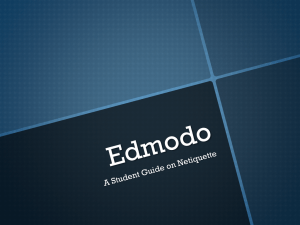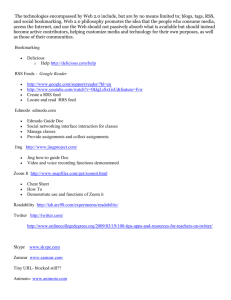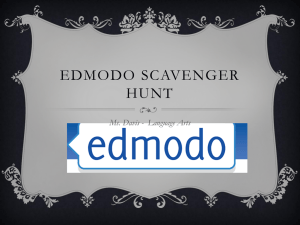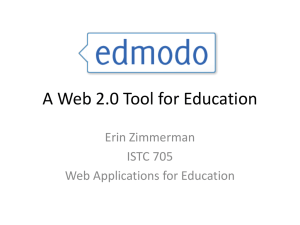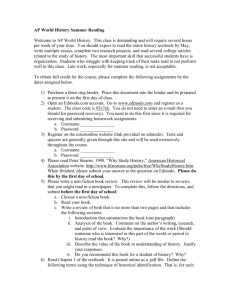Post-Secondary Emerging Technologies
advertisement
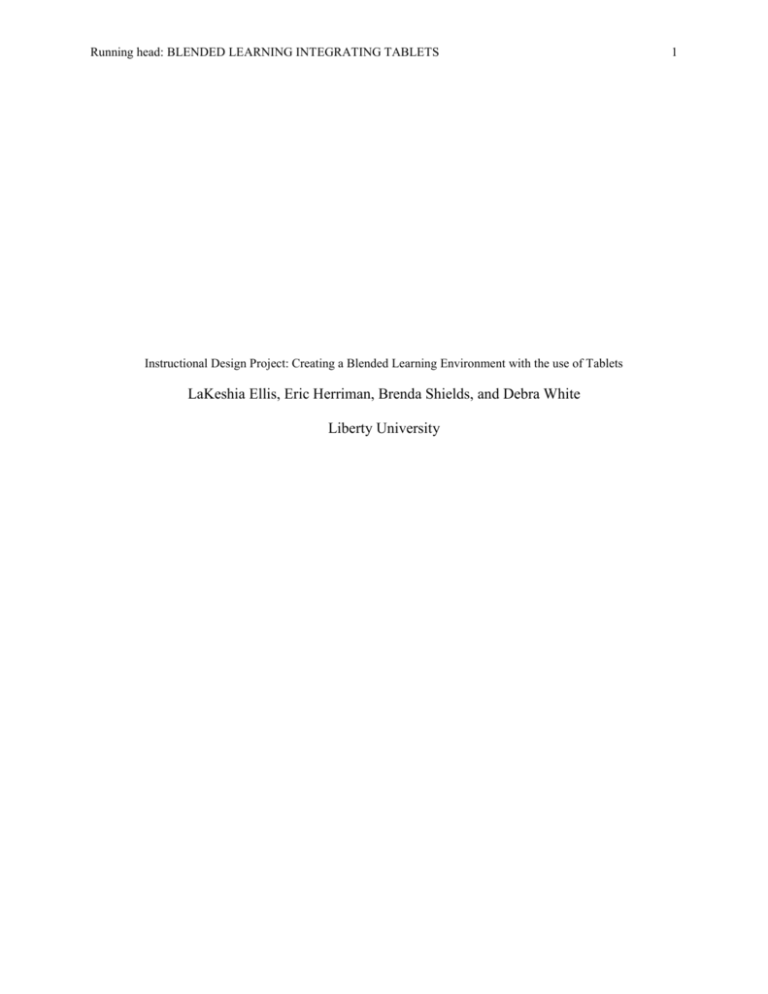
Running head: BLENDED LEARNING INTEGRATING TABLETS Instructional Design Project: Creating a Blended Learning Environment with the use of Tablets LaKeshia Ellis, Eric Herriman, Brenda Shields, and Debra White Liberty University 1 BLENDED LEARNING INTEGRATING TABLETS 2 Abstract This instructional design project (ISD) identifies a homeschool learning environment that has expressed the need for increased interactivity in the homeschool students’ classical education pursuit. Classical education consists of a focus upon time honored educational traditions tailored toward developing the cognitive development of students. History, art, cultures, languages, literature, philosophy, and a biblical worldview are all core elements of a classical education (Classical Conversations, 2013). The interest of the homeschool association is to integrate tablets into their learning environment thus enabling the student to access the vast amounts of information and social learning tools on the World Wide Web (WWW). Tutors and parentteachers will utilize Edmodo to develop and administer the lessons, reviews, assessments, and will provide feedback as required during the classical education process. The use of Edmodo will be presented through instructional videos. A science lesson will be used as an example to demonstrate the role in which the students to access Edmodo and the WWW to complete their educational pursuit will utilize tablets. Keywords: Blended learning, Edmodo, tablets, homeschool BLENDED LEARNING INTEGRATING TABLETS 3 Instructional Design Project: Creating a Blended Learning Environment with the use of Tablets Electronic tablets and similar physically, small electronic devices have become more and more popular within our culture to include the culture within our western educational systems (Johnson, Adams, & Cummins, 2012). Tablets have seemingly replaced a pen and pad of paper for taking notes for many on a daily basis. Educational administrators within school districts even use them to accomplish teacher’s evaluations. As educators we cannot ignore this popular trend. We must educate ourselves in which manners such technologies can be used to improve learning among our students. In this ISD we will share what we have learned about the use of tablets in relation to the use of Edmodo, an online software program used to administer educational curriculum to students. We will discuss the driving factor behind the need for this research, the analysis, the goals, objectives, assessment, and instructional strategy for including tablets in the use of Edmodo with our tutors, parent-teachers, and students involved with a homeschool co-op. Needs Analysis The relationship of our project to Classical education “is best understood when we put technology in its proper place as “tools.” Classical education is a philosophy of integrating subjects and thinking skills that supersede which tools we use. It has been going on for centuries without web 2.0 and virtual spaces quite well.” Our goal in combining CE and technology “is to reach this digital age where they are at on the one hand; and to accelerate rhetorical dialogue on the other. Computer data driven tools have an anytime anywhere capacity that allow more of this throughout our days/weeks. Because it can happen asynchronistically, students can take the time to develop their ideas and arguments in a well-researched manner and get back to the group with a more substantive response. It can also occur in real time when they are getting quicker at BLENDED LEARNING INTEGRATING TABLETS 4 thinking on their feet.” (White, 2013) Classical education at the high school level requires increasing levels of dialectical and rhetorical thought expressed in their work. The rhetoric will be dialogue-based, whether it is written or verbal, even though the home school group meets only one day per week. The expressed need of this project is to use technology to increase communication throughout the week via the Internet both synchronistically and asynchronistically thus increasing the opportunity for dialogue. This will enable small group activity, which provides for a more quality learning experience and is generally less intimidating (Horton, 2012, p. 576). This is an expressed need established with the consensus of the students, parents, and governing administrators of Classical Conversations curriculum. Goal Statement The wish of the Classical Conversations homeschool co-op is for the parent-teachers, tutors, and students to achieve the goals outlined by the International Society for Technology in Education (ISTE) and to exercise the use of tablets this coming school year in order to achieve our local goals (ISTE, 2012). This year tutors will establish our science courses within an online learning program called Edmodo. Parent-teachers and students will be able to access the science material through the use of Edmodo. The syllabus, lessons, assignments, schedules, and other associated course material will be accessible through Edmodo as well. The following is a flowchart and list of goals for tutors, parent-teachers, and students as they utilize their tablets in accessing their educational material through Edmodo (Figure 1). Abbreviated Goal Statement: Our local goal is for tutors, parent-teachers, and students to utilize their tablets for administering and completing their course work in the curriculum. courses. BLENDED LEARNING INTEGRATING TABLETS Goal 1: Tutors will establish their account, groups, and folders on Edmodo. Goal 2: Parent-teacher establishes their account on Edmodo. 5 Goal 3: Parent-teacher incorporates Edmodo LO’s into home schooling for their students. Goal 4: Students create an account in Edmodo and learn how to collaborate on it. Figure 1. Goal 1: Tutors will establish their account on Edmodo. - Create a teaching account. - Create and offer via email online aptitude self-reporting evaluation. - Create a group for parent-teachers and students. - Invite parent-teachers to join the group utilizing the group code. Please note to lock the group code once the appropriate parent-teachers have joined. - Screen capture a session for parent-teacher and student training purposes on utilizing folders, the library, responding to poll, sharing notes, posting videos and discussion responses, and online participation in assignments and quizzes. These will be referred to as Learning Objects (LO). - Pre-teach basic digital citizenship skills regarding posts, online safety, and netiquette. Goal 2: Parent-teacher will establish their account on Edmodo. - See training in Goal 1 and reinforce these skills to students. BLENDED LEARNING INTEGRATING TABLETS - Join a group for parent-teachers and students. - Invite students to join the group utilizing the group code. Please note to lock 6 the group code once the appropriate students have joined. - Direct students to establish an Edmodo account and provide training to students if needed for the establishment of the account. Goal 3: Parent-teacher incorporates Edmodo LO’s into home schooling for their students. - Explores folders related to the applicable class and selects LO’s desired for use - Uses the Edmodo library with learning materials for student at home online. - Create notes for students. - Post a video for the class - Select assignments and quizzes for their students. - Weigh in values from tutor grade book into students’ overall grade. Goal 4: Students create an account in Edmodo. - Demonstrate your ability to log onto Edmodo and join the assigned group. - Review the applicable educational materials in the folder for your class. - Complete an assignment and take a quiz. - Correspond with your parent-teacher and other students. We also expect our parent-teachers and tutors to collaborate to achieve the following teacher standards outlined by the ISTE (ISTE, 2012): 1. Facilitate and inspire student learning and creativity. BLENDED LEARNING INTEGRATING TABLETS 7 2. Design and develop digital age learning experiences and assessments. 3. Model digital age work and learning. 4. Promote and model digital citizenship and responsibility 5. Engage in professional growth and leadership. (ISTE, 2012) We expect our students to achieve the student standards outlined by the ISTE (ISTE, 2012). 1. Demonstrate creativity and innovation. 2. Utilize digital technology for communication and collaboration. 3. Express fluency in their digital research and use of information. 4. Exercise critical thinking, problem solving, and decision making with digital tools and resources. 5. Understand and express their position in digital citizenship. 6. Demonstrate a sound understanding of technology operations and concepts. (ISTE, 2012) Task Analysis This project will identify and apply appropriate tablet friendly tools in an Edmodo classroom environment for video examples, assigning projects, creating groups, and facilitation of dialogue synchronistically and asynchronistically. By selecting tools amenable to a variety of devices we increase the ability for all students to participate through the ones they already access BLENDED LEARNING INTEGRATING TABLETS 8 outside of physical class time. We will also show how to get the tutor, parent-teachers, and students set up in their online roles. Learner and Context Analysis The learners in the Classical Conversations homeschool co-op in the Challenge 1 class consist of students in grades eight through ten. The philosophy of this curriculum is to train and lead the parents as teachers of their own students. It is a blended learning environment, using both live classroom time and online class work. Class time of both types occur in the home individually and in the classroom as a group once per week. The student and their parentteachers are supported in learning through a tutor who is contracted for the year to guide the curriculum with subject examples, assignments, and facilitation of rhetorical projects and debate. Within the body of homeschool students we must be prepared to meet the needs of not only the average student but the needs of the student with learning disabilities and those who have advanced learning abilities. For those students with disabilities related to using the tablet technology, we will consider options within our realm of capabilities to assist them and then turn to outside resources for support. The Accessible Technology Coalition (ATC) is one such organization with vast amounts of information related to technologies and services related to the use of technology for those with disabilities (ATC, 2011). ACT provides news releases as well to provide updated technology information. For example, one news brief identified the Swiss National Association of and for the Blind (SNAB) collaborating with technological organizations to develop a product which will read PDF documents aloud for those who are visually impaired (ATC). We must also be prepared to not hinder the progress of students with advanced learning capabilities. Advanced students are youth in the cognitive developmental ages from eleven to BLENDED LEARNING INTEGRATING TABLETS 9 adult hood or around the onset of puberty begin to think and develop into the forms and characteristics of an adult (Slavin, 2009). Slavin believes adolescent youth generate abstract relationships from available information and compare those abstract relations to each other in order to apply the acquired skills underlying many tasks. This is when adolescents’ competency leaps forward. John Carroll proposed the QAIT model for school learning. QAIT stands for quality of instruction, appropriate levels of instruction, incentive, and time (Huitt, 2000). The QAIT model encompasses two learning functions: (1) time actually spent on learning, (2) time needed to learn (Slavin, 2009). The QAIT model for instruction includes (1) Quality of instructions, (2) Appropriate levels of instruction, (3) incentive and (4) time. To ensure that instruction is effective each of the four elements must be adequate. These standards are best practices in teaching and learning in technology and they will guide our work in this project (ISTE, 2012). Objectives and Assessments Objective 1: Tutors create an Edmodo account. Objective 1.1: After viewing the instructional video provided on the appropriate weblink, the tutor will demonstrate their ability to access the WWW using the electronic device of their choosing, i.e. tablet, laptop, mobile device, or desktop computer. Objective 1.2: Upon accessing the WWW they will demonstrate their ability to create an Edmodo account. Objective 1.3: After creating the account they will develop a group for parentteachers and students, invite parents to participate in the group, and lock the group upon the acceptance of the required parent-teachers. BLENDED LEARNING INTEGRATING TABLETS 10 Objective 1.4: They will then, utilizing screen capture software, develop an instructional video for parent-teachers explaining how to use folders, populate the library, share notes, post videos, create assignments and quizzes, create a grade book and perform other various administrative actions available to the administrator of a group. Objective 1.5: Provide instruction to parent-teachers and students regarding digital citizenship. Assessment 1: The tutor will post the instructional video to the library, post an assignment for students to view the video, and provide feedback to the students using the grade book. This should be accomplished so the tutor can complete two out of the three tasks without assistance. Objective 2: Parent-teachers create an Edmodo account Objective 2.1: After viewing the instructional video provided on the appropriate weblink, the parent-teacher will demonstrate their ability to access the WWW using the electronic device of their choosing, i.e. tablet, laptop, mobile device, or desktop computer. Objective 2.2: Upon accessing the WWW they will demonstrate their ability to create an Edmodo account. Objective 2.3: After creating the account they will invite students to participate in the group, and lock the group upon the acceptance of the required students. Objective 2.4: Parent-teachers will provide training as needed to ensure the students accurately demonstrate their ability to navigate within Edmodo. BLENDED LEARNING INTEGRATING TABLETS 11 Assessment 2: The parent-teacher will create a dialogue with students related to a class related topic, complete one of the students’ assignments, and take a quiz. This should be accomplished so the parent-teacher can complete two out of the three tasks without assistance. Objective 3: Parent-teachers will demonstrate the ability to incorporate LO’s at home for their students. Objective 3.1: Utilizing the electronic device of their choosing, i.e. tablet, laptop, mobile device, or desktop computer, parent-teachers will demonstrate the ability explore folders and select LO’s for students. Objective 3.2: Show the content of the library to students, post notes, videos, select assignments and quizzes, and communicates with tutor concerning students’ performance. Assessment 3: The parent-teacher will share a screencast displaying the ability to populate the library, post notes, videos, and other material. This should be accomplished so the parentteacher can complete three out of the four tasks without assistance. Objective 4: Students create an Edmodo account. Objective 4.1: After viewing the instructional video provided on the appropriate weblink, the student will demonstrate their ability to access the WWW using the electronic device of their choosing, i.e. tablet, laptop, mobile device, or desktop computer. Objective 4.2: Upon accessing the WWW they will demonstrate their ability to create an Edmodo account. BLENDED LEARNING INTEGRATING TABLETS Objective 4.3: They will then participate in a joint session with other students creating dialogue, completing an assignment, or taking a quiz. Assessment 4: Students will access their Edmodo account, create dialogue with other students and parent-teacher or tutor, complete an assignment, and take the quiz. The task shall be completed so two out of the four tasks without assistance. 12 BLENDED LEARNING INTEGRATING TABLETS 13 Goals and Objectives Flowchart Goal 1: Tutors will establish their account, groups, and folders on Edmodo. Obj. 1.1 Using tablet, access WWW Goal 2: Parent-teacher establishes their account on Edmodo. Obj. 2.1 Using tablet, access WWW. Obj. 1.2 Create an account in Edmodo. Obj. 3.1 Demonstrate ability to explore folders and select LO’s. Obj. 2.2 Create an account in Edmodo. Obj. 2.4 Provide training for students in using Edmodo. Pre-Instruction Survey Obj. 1.5 Provide instruction to parent-teachers and students regarding digital citizenship. Goal 4: Students create an account in Edmodo and learn how to collaborate on it. Obj. 4:1 Using a tablet or other electronic device, demonstrate ability to access WWW. Obj. 3.2 Show students the library content and functions within Edmodo. Obj. 2.3 Invite students to participate in a group. Obj. 1.3 Create a group in Edmodo and invite users. Obj. 1.4 Record a screen share session of using Edmodo for training purposes. Goal 3: Parent-teacher incorporates LO’s into home schooling for students. Obj. 4.2 Demonstrate ability to create Edmodo account. Obj. 4.3 Participate in a joint session with other students creating dialogue and accomplishing tasks. BLENDED LEARNING INTEGRATING TABLETS 14 Please answer the following questions and complete the technology survey below. 1. Do you have a computer? _yes __no If yes, are your skills ___Basic ___Average __ Proficient 2. Do you own an iPad or tablet? _ yes __no If yes, are your skills ___Basic ___Average __ Proficient 3. Do you own a smartphone? _ yes __ no If yes, are your skills ___Basic ___Average __ Proficient 4. Do you have an email account? ___yes ___ no Please rate your technology skills. Select one for each question I cannot perform this task Usage Of Internet Usage Of Microsoft Word Connect & Use Google Docs Connect & Use Skype Connect & Use Google Doc I can perform this task with a lot of assistance I can perform this task with minimal assistance I can perform this task without any assistance I have never heard of this BLENDED LEARNING INTEGRATING TABLETS 15 Usage Of Edmodo Usage Of digital Camera Usage Of Search Engines Usage of Microsoft Excel Usage of Microsoft PowerPoint How to Use 1. How to use Google docs ~ http://www.youtube.com/watch?v=OBh8bMC7XEU 2. How to use Google hangouts ~ http://www.youtube.com/watch?v=7K06lHu4gDk 3. How to build an app ~ a. http://campaigns.conduit.com/Mobile/make_free_app/ b. http://www.caspio.com/l/default.ashx?s=16&gclid=CKyx2aXYvLgCFRKZ4AodtG 8A6w 4. Learn Microsoft word ~ http://www.lynda.com/Word-2010-tutorials/essential-training/ 5. Learn Microsoft excel ~ http://www.lynda.com/Excel-training-tutorials/ 6. Learn Microsoft PowerPoint ~ http://www.lynda.com/PowerPoint-training-tutorials/ 7. How to use Library of Congress website ~ http://www.loc.gov/rr/askalib/ 8. How to use YouTube downloader~http://www.youtube.com/watch?v=dGsenuf9Xd8 9. APA Format - General Style Rules - Psychology ~ http://psychology.about.com/od/apastyle/a/apageneral.htm BLENDED LEARNING INTEGRATING TABLETS 16 Science Lesson for Edmodo The following science lesson is an example that demonstrates the role in which tablets will be utilized by the students to access Edmodo and the WWW to complete their educational pursuit. This lesson is covered in the textbook Apologia: Exploring Creation with Physical Science. This lesson will target all levels of learners, from special needs, to our general education population and even our gifted learners. This can be found in the science section of the Edmodo folder. Lesson Plan In this course, students will learn a lot about the world around them and the Universe that they live in. Students will study a variety of topics. The study of these topics and many others like them are all a part of what we call Physical Science. The lesson below will focus on the three non-contact forces. Non- contact Forces Background: “A Force is a push or pull upon an object resulting from the object's interaction with another object. Whenever there is an interaction between two objects, there is a force between the two objects. When the interaction stops, the objects no longer experiences forces. Forces only exist as a result of interactions.” (Henderson, 1996-2003) Forces between interactions can be placed into two broad categories: Contact Forces o Contact forces are forces that result when the two interacting objects appears to be physically contacting each other. Some examples of contact forces include BLENDED LEARNING INTEGRATING TABLETS 17 frictional forces, tensional forces, normal forces, air resistance forces, and applied forces. (Henderson, 1996-2003) Action at a Distance Forces o Action-at-a-distance forces are forces that result even when the two interacting objects are not in physical contact with each other, yet are able to exert a push or pull despite their physical separation. Some examples of action-at-a-distance forces include magnetic forces, electric forces and gravitational forces. An example of magnetic force would be when two magnets can exert a magnetic pull on each other even when separated by a distance of a few centimeters. An example of gravitational force is when the sun and planets exert a gravitational pull on each other despite their large spatial separation. An example of electric force is when the protons in the nucleus of an atom and the electrons outside the nucleus experience an electrical pull towards each other despite their small spatial separation. (Henderson, 1996-2003) Distant Forces and Contact forces are fun, but in this lesson students will explore three non-contact forces; these forces can move objects without even touching them! 1. Pre-lesson Questions: 1. Make a prediction on what you think will happen when magnets and paper clips are in the same 2. Make a prediction on what you think will happen when you rub a balloon across your hair and it comes in close contact with a Ping-Pong ball. BLENDED LEARNING INTEGRATING TABLETS 3. Make a prediction on what you think will happen when you add water in a cup on your “flippy board”. 2. Assignment (some components comes from the InteractiveScienceTeacher): Materials per Group Of Students: magnet(s), small paper clip tied to thin string, balloon with spot marked on it, ping pong ball, small cup with water, “flippy board” Record each demo and post to Edmodo, so students can see how to do each demo Procedure: 1. Introduce forces. Some are Contact, others can be Non-contact (which will be called “Distant”). 2. Have students write “Distant Forces” in their science notebook in Edmodo and its definition and give examples. 3.Have students watch Demo 1- Magnetism: a. Then tell them to define “Magnetism” in their science notebook b. Students are to watch the how to do demo 1-paper clip attracted up towards magnet c. Then students will try the demo and observe what is happening d. Students are to take a picture of what they did and upload their pictures in Edmodo in the proper folder e. In their Science notebook in Edmodo students are to write a one sentence summary. Share with classmates in Edmodo using the discussion board feature. 4.Repeat for #2-Electricity (static balloon attracts a ping pong ball) 18 BLENDED LEARNING INTEGRATING TABLETS 19 5.Repeat for #3-Gravity (cup of water on “flippy board”) 3. Post Assignment Questions 1. Summarize your Observations from the Magnetism activity. Why do you think this happened? 2. Summarize your observations from the Electricity activity. Why do you think this happened? 3. Summarize your observations from the Gravity activity. Why do you think this happened? 4. Compare and Contrast the three different activities. Why do you think this happened? 4. Projects (can be done as an extension to the above activity and shared on Edmodo) Students are to choose one of the following projects and upload them in the proper Edmodo folder Students will then use Photo Pad which is an app that can be downloaded to their tablet and share photos of what they have done, and upload them to their Edmodo account Students can use the Animoto HD app to create animations to use with their Edmodo account explain what they have done. Students can also collaborate using Google Docs and their documents can be viewed using GoDocs. Digital Citizenship Students understand human, cultural, and societal issues related to technology and practice legal and ethical behavior. Students: BLENDED LEARNING INTEGRATING TABLETS 20 advocate and practice safe, legal, and responsible use of information and technology. exhibit a positive attitude toward using technology that supports collaboration, learning, and productivity demonstrate personal responsibility for lifelong learning exhibit leadership for digital citizenship http://www.iste.org/standards/nets-for-students/nets-student-standards-2007 Nine Elements of Digital Citizenship 1. Digital Access: full electronic participation in society. Technology users need to be aware that not everyone has the same opportunities when it comes to technology. Working toward equal digital rights and supporting electronic access is the starting point of Digital Citizenship. Digital exclusion makes it difficult to grow as a society increasingly using these tools. 2. Digital Commerce: electronic buying and selling of goods. Technology users need to understand that a large share of market economy is being done electronically. Users need to learn about how to be effective consumers in a new digital economy. 3. Digital Communication: electronic exchange of information. One of the significant changes within the digital revolution is a person’s ability to communicate with other people. The expanding digital communication options have changed everything because people are able to keep in constant communication with anyone else. Now, everyone has the opportunity to communicate and collaborate with anyone from anywhere and BLENDED LEARNING INTEGRATING TABLETS 21 anytime. Unfortunately, many users have not been taught how to make appropriate decisions when faced with so many different digital communication options. 4. Digital Literacy: process of teaching and learning about technology and the use of technology. Learners must be taught how to learn in a digital society. In other words, learners must be taught to learn anything, anytime, anywhere. As new technologies emerge, learners need to learn how to use that technology quickly and appropriately. Digital Citizenship involves educating people in a new way— these individuals need a high degree of information literacy skills. 5. Digital Etiquette: electronic standards of conduct or procedure. Learners need to recognize inappropriate behavior when they see it, but before people use technology they do not learn digital etiquette (i.e., appropriate conduct). Many people feel uncomfortable talking to others about their digital etiquette. There are rules and regulations that are created or the technology is simply banned to stop inappropriate use. It is not enough to create rules and policy, we must teach everyone to become responsible digital citizens in this new society. 6. Digital Law: electronic responsibility for actions and deeds. Digital law deals with the ethics of technology within a society. Unethical use manifests itself in form of theft and/or crime. Ethical use manifests itself in the form of abiding by the laws of society. Users need to understand that stealing or causing damage to other people’s work, identity, or property online is a crime. There are certain rules within society that users need to be aware, when followed, these rules create an ethical society. These laws apply to anyone who works or plays online. Hacking into others information, downloading illegal music, plagiarizing, BLENDED LEARNING INTEGRATING TABLETS 22 creating destructive worms, viruses or creating Trojan Horses, sending spam, or stealing anyone’s identify or property is unethical. 7. Digital Rights & Responsibilities: those freedoms extended to everyone in a digital world. Digital citizens have the right to privacy, free speech, etc. Basic digital rights must be addressed, discussed, and understood in the digital world. With these rights also come responsibilities as well. Users must help define how the technology is to be used in an appropriate manner. In a digital society these two areas must work together for everyone to be productive. 8. Digital Health & Wellness: physical and psychological well being in a digital technology world. Eye safety, repetitive stress syndrome, and sound ergonomic practices are issues that need to be addressed in a new technological world. Beyond the physical issues are those of the psychological issues that are becoming more prevalent such as Internet addiction. Users need to be taught that there inherent dangers of technology. Digital Citizenship includes a culture where technology users are taught how to protect themselves through education and training. 9. Digital Security (self-protection): electronic precautions to guarantee safety . As responsible citizens, we must protect our information from outside forces that might cause disruption or harm. Storyboard BLENDED LEARNING INTEGRATING TABLETS Media Selection 23 BLENDED LEARNING INTEGRATING TABLETS The hardware and software utilized for this course will be an individual choice for the tutor, parent-teacher, and student. These selections however must possess the capabilities of accessing the WWW, viewing websites such as Edmodo, YouTube, Google Hangout, and the presentation documents related to this course. The following are recommended additional hardware support requirements (Liberty University, 2013): Camera (Built-in or detachable) Speakers (Built-in or detachable) Operating system-Windows 7/8 or Mac OS X 10.6.8 or most recent Processor: i-Series (i3. I5, i7) RAM-4GB or greater Hard drive-120GB or greater Video memory-256MB or greater The following are recommended additional software support requirements: Java Microsoft Office Internet Explorer 10 (Recommended, 7.0 is adequate) Google Chrome 24 BLENDED LEARNING INTEGRATING TABLETS 25 Mozilla Firefox Safari The tutor and parent-teacher must possess the ability to effectively use the aforementioned hardware and software to be successful in this course. It is recommended that the following skills be developed prior to participating in this course: Advanced computer skills Efficient navigation and basic troubleshooting of functions on the WWW Creating educational courses in Edmodo Recording, editing, and publishing of videos in YouTube Develop PowerPoint presentations Monitor and critique student work online Advanced communication skills in e-mail, chat, and blog The student must possess the ability to effectively use the aforementioned hardware and software to be successful in this course. It is recommended that the following skills be developed prior to participating in this course: Basic computer skills Navigating the WWW Navigating and using Edmodo BLENDED LEARNING INTEGRATING TABLETS Accessing and utilizing the functions of video functions in YouTube Use of PowerPoint for reading and viewing presentations Access and submit online assignments Basic communication skills in e-mail, chat, and blog References 26 BLENDED LEARNING INTEGRATING TABLETS 27 Accessible Technology Coalition (2011). Free PDF reader for visually impaired people. Retrieved from http://atcoalition.org/news/free-pdf-reader-visually-impaired-people Classical Conversations (2013). What is Classical Education? Retrieved from http://www.classicalconversations.com/common/what-is-classical-education Ellis, L., Herriman, E., Shields, B. & White, D. (2013). Herriman 633 Blended Learning. Team Blended Learning. Retrieved from http://www.youtube.com/watch?v=mzmKVrRJ3X4 Ellis, L., Herriman, E., Shields, B. & White, D. (2013). 633 ISD Summer D 2013. Team Blended Learning. Retrieved from http://www.youtube.com/watch?v=3nAc-XGhqfU Ellis, L., Herriman, E., Shields, B. & White, D. (2013). Herriman 633 Session #2. Team Blended Learning. Retrieved from http://www.youtube.com/watch?v=JPTGJ9qAxpE Ellis, L., Herriman, E., Shields, B. & White, D. (2013). Team Blended Learning. Herriman 633 #3. Retrieved from http://www.youtube.com/watch?v=sIRAL7ZpKSg Henderson, T. The Physic Classroom. (1996-2013) Retrieved from http://www.physicsclassroom.com/Class/newtlaws/U2L2a.cfm Horton, W. (2012). E-Learning by design. San Francisco, CA: Pfeiffer. Huitt, W. (2000). Slavin’s QAIT model. Educational Psychology Interactive. Retrieved from http://www.edpsycinteractive.org/topics/process/QAIT.html International Society for Technology in Education (2012). Nets-s Student Standards. Retrieved from http://www.iste.org/standards International Society for Technology in Education (2012). Nets-t Teacher Standards. Retrieved from http://www.iste.org/standards Johnson, L., Adams, S., & Cummins, M. (2012). The NMC horizon report: 2012 higher education edition. Austin, Texas: The New Media Consortium. BLENDED LEARNING INTEGRATING TABLETS 28 Liberty University (2013). IT Marketplace Policies. Retrieved from http://www.liberty.edu/informationtechnology/itpurchasing/index.cfm?PID=23334#hard ware Slavin, R. E. (2009). Educational psychology theory and practice. Columbus, Ohio: Pearson. White, D. L. (2013). Diving into Education. Retrieved from http://dlwhitemich.wordpress.com/2013/07/24/isd-book-review/#comments Wilkinson, B. Interactive Science Teacher. Retrieved from http://www.interactivescienceteacher.com/distantpreview/. forces-physical-science-lessons- BLENDED LEARNING INTEGRATING TABLETS Permission from Dr. Mike Ribble for the use of the Nine Elements of Digital Citizenship LaKeshia, Thank you for contacting me. Yes, you are very welcome to use the nine elements as a part of your lesson. Good luck on your project and please let me know if I can be of further assistance. Mike Dr. Mike Ribble, Ed.D. http://www.digitalcitizenship.net mribble@yahoo.com The Physics Classroom About Page About the Physics Classroom The Physics Classroom is an online, free-to-use physics website developed primarily for high school physics students and teachers. The website features a variety of sections intended to support both teachers and students in the tasks of learning and teaching physics. 29
